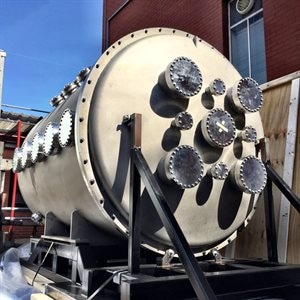Apr 10 2017
Dark matter influences the stars and galaxies around us, but despite being everywhere you can’t actually see it. The existence of dark matter is inferred from its gravitational interactions, but it has never been directly detected in a terrestrial laboratory. This week, Astrophysicists at Royal Holloway‘s Department of Physics have begun installing a dark matter detector at the university's Egham campus for advanced collaborative research into measuring dark matter and its fundamental properties.
 A crane was needed to manouvre the large dark matter detection vessel into the Physics lab (Credit: Royal Holloway, University of London)
A crane was needed to manouvre the large dark matter detection vessel into the Physics lab (Credit: Royal Holloway, University of London)
Commissioned last year from Massachusetts Institute of Technology (MIT), the exciting arrival of equipment will continue developing on campus with new micropattern detector for the time projection chamber readout and explore application to neutrino physics.
In an interview about searching for dark matter wind in Symmetry magazine, an online publication about Particle Physics, Jocelyn Monroe, Professor of Physics at Royal Holloway talks about her international research, and says,
“It’s a big, big prize to go after. If you could correlate detections with the direction in which the planet is moving you would have ‘unambiguous proof’ of dark matter.”
Professor Monroe currently works on two dark matter detection experiments, as leader of the DMTPC - The Dark Matter Time Projection Chamber, an experiment for direct detection of weakly interacting massive particles (WIMPs), one of the most favoured candidates for dark matter and on DEAP-3600 at SNOLAB, in Canada. The DEAP experiment (Dark Matter Experiment using Argon Pulse-shape discrimination), uses extraordinary apparatus located 2 km underground in Ontario, Canada. The detector consists of 1 ton of liquid argon surrounded by photomultiplier tubes that will pick up the small flashes of ultraviolet light that are expected when WIMPs hit an atomic nucleus in the liquid.
The search for dark matter is a worldwide collaboration of scientists from five different directional dark matter experiments, involving a large team of Royal Holloway staff and students based at the Centre for Particle Physics.